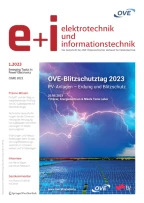Abstract
Transient voltage suppressors (TVS) are widely used for electrostatic discharge (ESD) and surge protection of electronic devices. Especially the usage of mobile devices for wireless communications requires extremely high production quantities in the range of multi-billion pieces of TVS per year. This article gives an introduction to the key performance parameters of different TVS technologies with low parasitic capacitance in the picofarad and sub-picofarad range, such as gas discharge tubes (GDT), polymer voltage suppressors (PVS), multi-layer varistors (MLV) and silicon TVS.
Zusammenfassung
Transient Voltage Suppressors (TVS) werden weitverbreitet zum ESD-Schutz sowie zum Überspannungsschutz von elektronischen Produkten eingesetzt. Speziell die stark wachsende Anwendung von Mobiltelefonen erfordert extrem hohe Fertigungsvolumen von ESD-Schutzbauelementen in Multi-Milliarden-Stückzahlen pro Jahr. Dieser Artikel gibt eine Einführung in die wichtigsten elektrischen Parameter von ESD-Schutzbauelementen sowie verschiedenen Technologien mit geringster parasitärer Kapazität im Picofarad- und Sub-Picofarad-Bereich. Es werden miniaturisierte Gasentladungs-Röhren (GDT), Polymer-ESD-Schutzbauelemente (PVS), Mehr-Lagen-Varistoren (MLV) und Silizium-TVS-Bauelemente beschrieben sowie deren typische Eigenschaften gezeigt.
Similar content being viewed by others
Notes
As an example the following simplified estimation of the number of ESD events at a heavily frequented cash dispenser: 1000 small to strong ESD events per day × 365 days × 10 years sums up to more than 3 million ESD events over life time.
References
International Electrotechnical Commission (2008): Electromagnetic compatibility (EMC), part 4-2: testing and measurement techniques—electrostatic discharge immunity test. 9th December 2008, ISBN 2-8318-1019-7, http://www.iec.ch/.
Simbürger, W., Johnsson, D., Stecher, M. (2012): High current TLP characterisation: an effective tool for the development of semiconductor devices and ESD protection solutions. In ARMMS RF & microwave society.
Wang, A. (2002): On-chip ESD protection for integrated circuits—an IC design perspective. Dordrecht: Kluwer Academic.
Infineon (2012): AN210—effective ESD protection design at system level using VF-TLP characterization methodology. Application note, 6 December 2012, http://www.infineon.com/dgdl?fileId=db3a30432cd42ee3012cee8d005b0c19.
Wunsch, C., Bell, R. (1970): Determination of threshold failure levels of semiconductor diodes and transistors due to pulse voltages. IEEE Trans. Nucl. Sci., 17, 346–372.
International Electrotechnical Commission (2005): Electromagnetic compatibility (EMC), part 4-5: testing and measurement techniques—surge immunity test. 29th November 2005, ISBN 2-8318-8371-7, http://www.iec.ch/.
International Electrotechnical Commission (2004): Electromagnetic compatibility (EMC), part 4-4: testing and measurement techniques—electrical fast transient/burst immunity test. 8th July 2004, ISBN 2-8318-7567-6, http://www.iec.ch/.
Raizer, Y. (1997): Gas discharge physics. Berlin: Springer.
Shrier, K., Jiaa, C. (2005): Cell phone GaAs power amplifiers: ESD, TLP, and PVS devices. In Proceedings of EOS/ESD symposium (pp. 1–10).
Bonfert, D., Gieser, H., Bock, K., Svasta, P., Ionescu, C. (2009): Pulsed behavior of polymer protection devices. In 32nd international spring seminar on electronics technology, ISSE, 2009 (pp. 1–6).
Shrier, K., Truong, T., Felps, J. (2004): Transmission line pulse test methods, test techniques and characterization of low capacitance voltage suppression device for system level electrostatic discharge compliance. In Proceedings of EOS/ESD symposium (pp. 1–10).
Miniature shield against overvoltages. Online available: http://en.tdk.eu/tdk-en/374108/tech-library/articles/products—technologies/products—technologies/miniature-shield-against-overvoltages/172782.
Reisch, M. (2007): Elektronische Baulemente, 2nd ed. Berlin: Springer.
ESD119-B1-W01005 bi-directional transient voltage suppressor, 5.5 V, 0.2 pF, 01005, RoHS and halogen free compliant. Online available: http://www.infineon.com.
Acknowledgements
The authors would like to thank Dr. Nicole Killat and Dr. Markus Sauter for silicon TVS sample preparation and photographs.
Author information
Authors and Affiliations
Corresponding author
Rights and permissions
About this article
Cite this article
Simbürger, W., Willemen, J., Vendt, V. et al. Transient voltage suppressors—technologies and characteristics. Elektrotech. Inftech. 133, 11–17 (2016). https://doi.org/10.1007/s00502-015-0383-5
Received:
Accepted:
Published:
Issue Date:
DOI: https://doi.org/10.1007/s00502-015-0383-5
Keywords
- transient voltage suppressor (TVS)
- gas discharge tube (GDT)
- polymer voltage suppressor (PVS)
- multi-layer varistor (MLV)
- electrostatic discharge (ESD)
